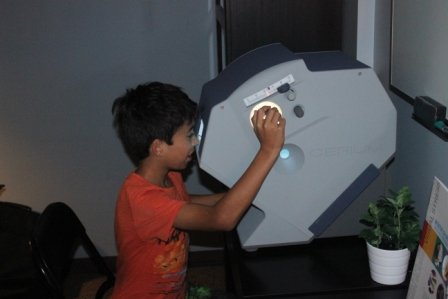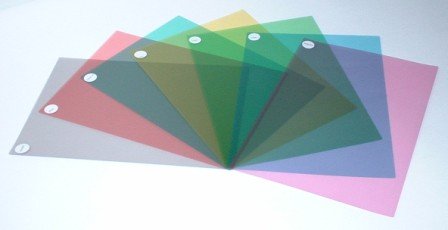Visual Dyslexia

Quick Facts about Visual Dyslexia
- Though dyslexia is primarily an auditory neurological processing issue,
the qualities of visual input and the effects of visual processing also impact upon reading
- Visual dyslexia is reading difficulty
resulting from optical problems located in the eye or visual processing
problems residing in the brain
- The cause of visual processing problems is not known, but it can result from numerous visual stressors including lighting, word density and color
- Common visual problems such as farsightedness, nearsightedness or 'convergence insufficiency' can also dramatically affect reading ability and are often mistaken for dyslexia
- Therapies for optical reading problems include basic corrective lenses and eye exercises
- Therapies for visual processing disorders (visual stress) include coloured paper, tinted lenses and coloured overlays. Some research has found that about 20% of dyslexics can benefit from these types of interventions
Definition
Visual dyslexia is reading difficulty resulting from either optical visual problems (physical causes) or visual processing disorders (cognitive/neurological causes).
Optical problems often result from simple near or far sightedness. Mental processing problems are often the result of visual stress
General Symptoms and Signs
Identifying a visual reading problem is difficult because young readers have never seen text differently and therefore cannot report that the text or words look less crisp, or different than they have before, or that they look different from what their friends see. If you've always seen letters moving about on the page, then from your perspective, that's just what letters do.
Here are some general signs you might see in someone who has difficulty with visual comfort or perception:
- Skipping words or lines while reading
- Squinting
- Preference to read in low light
- Rubbing eyes or blinking frequently
- Discomfort reading from monitors and screens
- Headaches / migraines
- Balance or coordination issues
- Poor fluency and comprehension
Symptoms and Signs (physical)
The signature symptoms of physical problems with the eye include
- Distant letters and objects appear blurry
- Nearby letters and objects appear blurry
- An inability to otherwise normally focus your eyes
Symptoms and Signs (cognitive)
Symptoms of visual processing difficulty also known as visual stress include:
Instability of text: Characters on the page may appear to move, change shape, flip, shake or slide off the page. View some sample distortions.
Illusions of light and colour: Colour may appear behind the text, in the spaces in between lines or at the edge of the page.
Depth perception difficulties: Difficulty accurately perceiving the depth of words or objects can result in problems with balance, coordination and even motion sickness.
Sensitivity to light: Visual stress resulting from different lights sources can result in headaches, migraines, sore eyes and fatigue.
Style and font problems: Small fonts, ornate fonts, and insufficient spacing between letters, words and lines can all impede reading
 Step one is see your optometrist
Step one is see your optometristCauses of Visual Dyslexia (physical)
Irlen Syndrome?
You may have heard about something called the Irlen Syndrome. As described by the California based Irlen company, it is a perceptual processing disorder resulting from visual stress that impedes reading but can be treated with coloured lenses.
An oft cited research paper found no benefits from their coloured lenses, but in fact there is a growing body of research indicating that coloured lenses and overlays do help some people with dyslexia.
Irlen is well known in the U.K., Australia and the U.S. but has a much lower profile in Canada.
The three most common physical causes of visual dyslexia are:
- Nearsightedness: Also known as myopia, this is the most common vision problem where objects in the distance appear blurry
- Farsightedness: Also known as hyperopia, and less common in school age children, this is the inability to focus on close objects, such as the text in a book
- Convergence insufficiency: according to the Mayo Clinic, convergence insufficiency occurs when
"your eyes don't turn inward properly while you're focusing on a nearby object. When you read or look at a close object, your eyes should converge—turn inward together to focus—so that they provide binocular vision and you see a single image. But if you have convergence insufficiency, you won't be able to move your eyes inward to focus normally."
Keep in mind that that none of these causes are reading or learning problems in themselves—they are visual problems that contribute to reading problems.
The exact cause of visual processing difficulty in the brain is not known, but may result from over activation of some areas. For more information try the studies below:
Causes of visual dyslexia (cognitive)
The cause of reading problems associated with mental processing is generally believed to be visual stress, sometimes referred to as Irlen Syndrome or Scotopic Sensitivity Syndrome. Exactly what is causing the stress in brain processing is unknown, but the articles below explore some possibilities.
A neurological basis for visual discomfort. Brain 107:989–1017 - Wilkins AJ, Nimmo-Smith I, Tait A, McManus C, Della Sala S,Tilley A, Arnold K, Barrie M, Scott S (1984).
fMRI evidence that precision ophthalmic tints reduce cortical hyperactivation in migraines. Cephalalgia 31(8):925–936 - Huang J, Zong X, Wilkins A, Jenkins B, Bozoki A, Cao Y (2011)
Some visual, optometric and perceptual effects of coloured glasses. Ophthal Physiol Opt 1:163–171 - Wilkins AJ, Neary C (1991)
Assessment
 The Intuitive Colorimeter helps identify the perfect color tint for each individual. (Taken at Opticalm Canada, Ottawa)
The Intuitive Colorimeter helps identify the perfect color tint for each individual. (Taken at Opticalm Canada, Ottawa)A visit to your optometrist should be among the first things you do when a child is struggling with reading, regardless of what the ultimate cause might be. At a minimum, the assessment can rule out near
and far sightedness. Of course tests of vision are even more important if you suspect that visual stress may be a factor.
Some optometrists or specialists in visual stress are able to conduct an assessment using colored overlays and/or tinted lenses. This is more commonly done by optometrists in the U.K. than in the U.S. or Canada. If your optometrist cannot perform these assessments, you may have to find a specialist in visual stress such as Opticalm (Canada) or Irlen (Canada, U.S., U.K.)
The assessment may involve the use of an Intuitive Colorimeter, which helps identify the precise tint that best reduces visual stress for the reader.
Treatment
Below is a summary of the most common and effective forms of intervention for vision related reading difficulty
|
 Coloured overlays can make a difference for some dyslexics |
- Coloured lenses: Coloured lenses are just like a pair of sunglasses except with a carefully chosen tint, that reduces visual stress for the person wearing them.
- Coloured overlays: Overlays are thin tinted sheets or transparent plastic that is placed over top of any material being read, serving the same function as the glasses.
- Choose simple fonts and styles. Review our font and style guide for information on how to improve the readability of text for dyslexics. A clean, sans serif font, 12pts or bigger on pastel paper with generous letter, word and paragraph spacing is about as good as it gets.
- A good reading program: If vision and visual processing are not implicated in your child's reading problems, then the best treatment remains a sound multisensory reading program based on the Orton Gillingham approach.
Our Story
Recently my stepson was given an overlay and precision tinted lens assessment at a cutting edge visual stress assessment centre here in Ottawa called Opticalm. This assessment did find some reductions in reading errors with an overlay, but overall did not find that visual stress was a major factor in his dyslexia.
I was impressed with the rigour, depth and technology of the assessment process. Despite the mostly negative finding, it is still enormously helpful to know what is not causing his reading difficulty. Now we can continue to focus on those things that are causing the problem—such as phonemic awareness and site word identification etc. While visual stress is only a small part of the picture for us, for others it can be a major factor. Definitely worth inquiring with your optometrist or a visual stress specialist.
Return to the top of Visual Dyslexia
- Home ›
- Types of Dyslexia ›
- Visual Dyslexia
Photo Credits:
Letter Eye: © Photojogtom. Dreamstime.com
Boy's Eyes Being Examined By Slit Lamp: © Tyler Olson. Dreamstime.com
New! Comments
Share your thoughts or ideas! Leave us a comment in the box below. You can post it at this site only or on Facebook too, it's up to you.